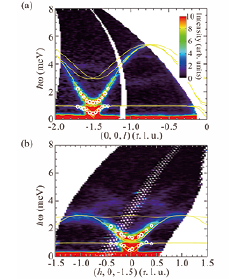Magnetic Model in Multiferroic NdFe3(BO3)4 Investigated by Inelastic Neutron Scattering
Masuda Group
Symmetry breaking of time reversal and space inversion allows spontaneous order both in magnetism and dielectricity. The enhanced simultaneous order, multiferroics [1], has been extensively studied since the discovery of its experimental realization in the perovskite manganite TbMnO3 [2]. The microscopic consideration of electronic states taking into account a spin-orbit interaction and symmetry of crystals reveals the relationship between the structures of spin and polarization. So far, in many multiferroic materials, the complex spin structure of the 3d transition metal ions has been focused in relation with induced electric polarizations. On the other hand, existence of an interaction between 4f and 3d ions (f-d coupling) and its importance on the multiferroic structure has not been in the spotlight. In this context, an easy-plane type antiferromagnet NdFe3(11BO3)4 provides a simple and interesting playground in which Nd and Fe moments are simultaneously ordered thorough the f-d coupling and the polarizations are simply described by a rank two tensor of local magnetic operators. Recently we performed inelastic neutron scattering (INS) measurements on single crystals of hexagonal NdFe3(11BO3)4 to explore the magnetic excitations, to establish the underlying Hamiltonian, and to reveal the detailed nature of hybridization between the 4f and 3d magnetism and its relation to the multiferroic structure by using state-of-the-art neutron spectrometer HRC [3].

Fig. 1. Inelastic neutron scattering spectra obtained using HRC, along the (a) c* and (b) a* directions. The curves are the calculated spin-wave dispersions.
The INS spectra projected onto ħω-c* and ħω -a* plane are shown in Figs. 1(a) and 1(b). We clearly observed the spin waves of the Fe3+ moments around AF zone center at q = (0,0, −1.5), and the flat excitation at about 1.0 meV from the crystal field of Nd3+ ion. Overall spectra are reasonably reproduced by spin-wave calculation including spin interaction in the framework of weakly coupled Fe3+ chains, f-d coupling, and single-ion anisotropy derived from the Nd3+ crystal field. Hybridization between the 4 f and 3d magnetism is probed as the anticrossing of the Nd- and Fe-excitations. The in-plane anisotropy gap at the AF zone center is explained solely by the crystal field of the Nd3+ ion in the quantitative level. The magnetic anisotropy of the Fe3+ ion allowed in the crystal structure is found to be negligibly small after the consideration on dipole-dipole interaction, single ion anisotropy, and spin nematic interaction as the origin of the in-plane anisotropy. Combination of the measurements and calculations revealed that the hybridization between 4 f and 3d magnetism propagates the local magnetic anisotropy of the Nd3+ ion to the Fe3+ network, resulting in the bulk magnetic structure. In the multiferroics of the spin-dependent metal-ligand hybridization type, the local magnetic anisotropy controls the electric polarization, meaning that the local symmetry of the rare-earth ion is a driving force for the nonlocal multiferroicity in NdFe3(11BO3)4.
References
- [1] W. Eerenstein, N. D. Mathur, and J. F. Scott, Nature (London) 442, 759 (2006).
- [2] T. Kimura, T. Goto, H. Shintani, K. Ishizaka, T. Arima, and Y. Tokura, Nature 426, 55 (2003).
- [3] S. Hayashida, M. Soda, S. Itoh, T. Yokoo, K. Ohgushi, D. Kawana, H. M. Ronnow, and T. Masuda, Phys. Rev. B 92, 054402 (2015).
